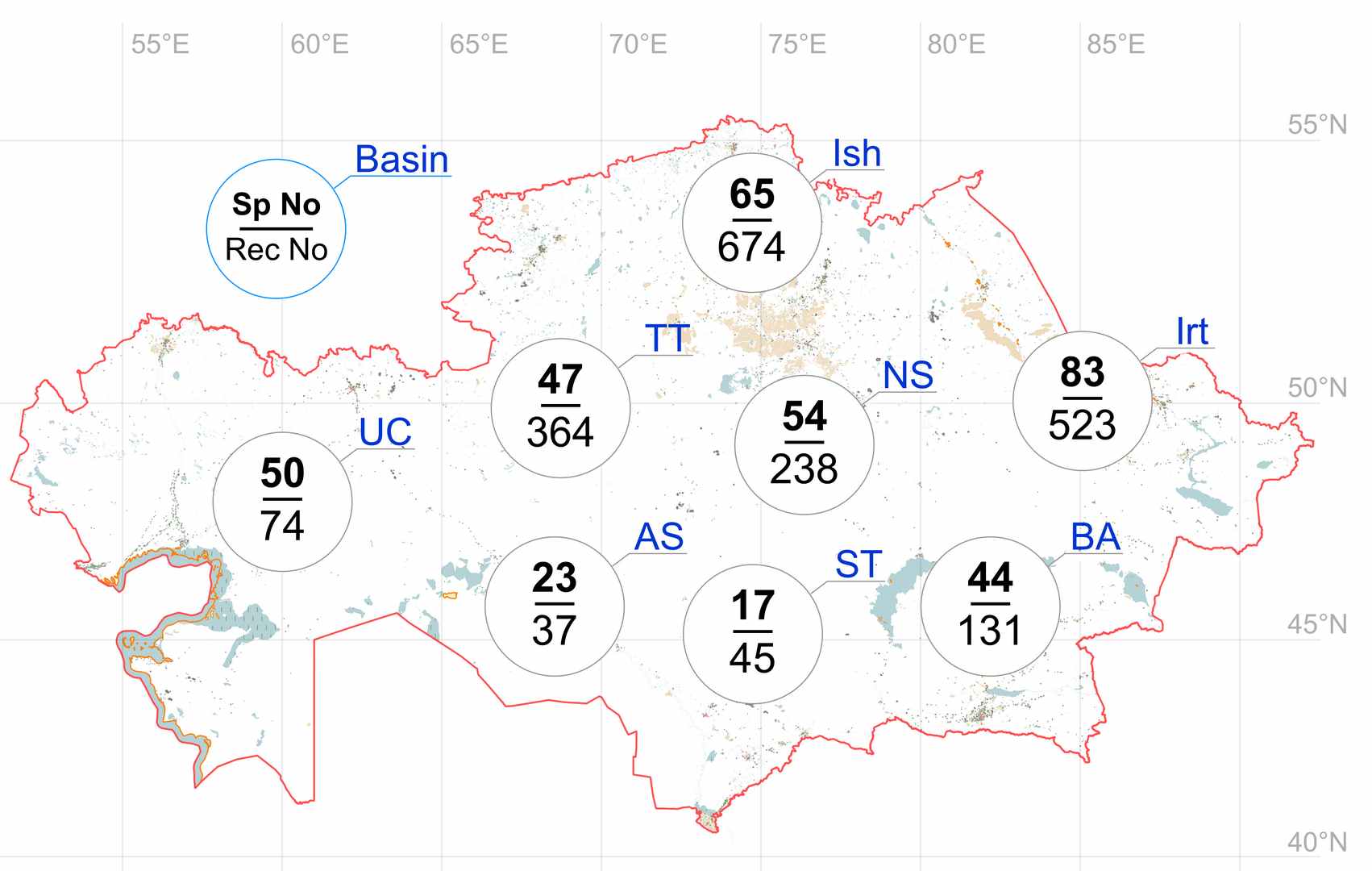Project Leader: Ivan O. Nekhaev
Implementation period: 2024–2026
IRN: AP22783298
PROJECT DESCRIPTION:
Freshwater mollusks are an important group of zoobenthos that play a key role in ecosystems, yet their taxonomic diversity and distribution remain insufficiently studied. Recent research has shown that many species previously considered endemic may have a wider distribution, and some regions of Kazakhstan may potentially serve as centers of mollusk diversity. To clarify the composition of the fauna and reconstruct its formation, modern taxonomic and molecular-phylogenetic studies are required. The study area covers the entire territory of Kazakhstan.

Distribution of species number (Sp No) and records (Rec No) of freshwater mollusks across river basins (Basin) in Kazakhstan. AS – Aral-Syrdarya, BA – Balkhash-Alakol, Irt – Irtysh, Ish – Ishim, NS – Nura-Sarysu, ST – Shu-Talas, TT – Tobol-Turgai, UC – Ural-Caspian.
Project goal: to provide a comprehensive assessment of the biological diversity and formation pathways of an important group of freshwater macrofauna — mollusks.
The project will address the following specific objectives:
1. To create the most complete database on the distribution of freshwater mollusks within Kazakhstan, based on museum collections, published data, and newly collected materials.
2. To analyze large-scale distribution patterns of freshwater mollusks in relation to climate, landscape features, and geographic position.
Within this task, a series of statistical tests will be performed using the compiled database to identify relationships between the distribution of particular species and assemblages and environmental variables such as temperature, snow-free period, and association with major river basins and landscape zones.
3. To verify the taxonomic status of several species previously described from Kazakhstan.
This will involve studying type series from museum collections and conducting anatomical and molecular-genetic analyses of mollusks.
4. To test hypotheses on the existence of specific centers of freshwater mollusk diversity within Kazakhstan (Zaysan, Balkhash, and Aral regions), using updated taxonomic and distributional data, along with molecular phylogenetic and phylogeographic methods.
5. To develop hypotheses on the timing and pathways of faunal formation in various regions of Kazakhstan, especially in the Northern Tien Shan, based on comparative faunistic and molecular-phylogenetic data.
EXPECTED RESULTS:
The project will result in a comprehensive database on the distribution of Kazakhstan’s freshwater mollusks, incorporating data from museum collections, scientific publications, and new field surveys.
The spatial analysis of mollusk distribution will reveal correlations between species occurrence and climatic factors, landscape characteristics, and basin affiliation.
The taxonomic status of several species will be refined through anatomical and molecular-genetic analyses.
The project will also test hypotheses regarding potential biodiversity centers of freshwater mollusks, such as the Balkhash and Aral regions. In addition, the research will help reconstruct historical pathways of freshwater fauna formation in Kazakhstan, particularly in the Northern Tien Shan region.
PROJECT TEAM:
Ivan O. Nekhaev – Project leader, PhD (Biology), Senior Researcher, Laboratory of Arachnology and Other Invertebrates. ORCID ID: 0000-0002-9464-715X, h-index 9
Anel A. Ishaева, MSc in Biology, Junior Researcher, Laboratory of Arachnology and Other Invertebrates. ORCID ID: 0009-0009-9578-4736, h-index 0
Leonid V. Kim, MSc in Biology, Junior Researcher, Laboratory of Arachnology and Other Invertebrates. ORCID ID: 0000-0003-1916-7639, h-index 0
Amina Muratkankyzy Omarova, BSc, Acting Junior Researcher, Laboratory of Arachnology and Other Invertebrates. ORCID ID: 0000-0002-8894-2240, h-index 0

Project participants: Ivan Nekhaev, Amina Omarova, and Anel Ishaева
RESEARCH RESULTS:
Summary of 2024 results
Analysis of museum collections, field data, and published sources made it possible to create a database containing 2,086 records of freshwater mollusks of Kazakhstan, including 1,088 based on original data.
The final list includes 115 species — 77 gastropods and 38 bivalves. The highest species diversity was recorded in the northern steppe regions, while the lowest was observed in the southern basins. All records were georeferenced to river basins and analyzed using GIS and cluster analysis, which revealed two major groups: southern basins associated with mountain areas and other regions without clear grouping.
To align the data with the current taxonomy, a conservative approach was applied, excluding controversial taxa except for potential Central Asian endemics that require further study. It was found that only six mollusk species occur in all major basins of Kazakhstan, emphasizing the significant regional differences in fauna.
LIST OF PUBLICATIONS:
Nekhaev I.O., Ishaева A.A., Babushkin E.S., Vinarsky M.V. Freshwater mollusks of Kazakhstan: preliminary analysis of taxonomic diversity // Proceedings of the 2nd International Scientific Conference “Mollusks: Biology, Ecology, Evolution, and Formation of Malacofaunas.” – Arkhangelsk: KIRA, 2024. – pp. 119–123.
